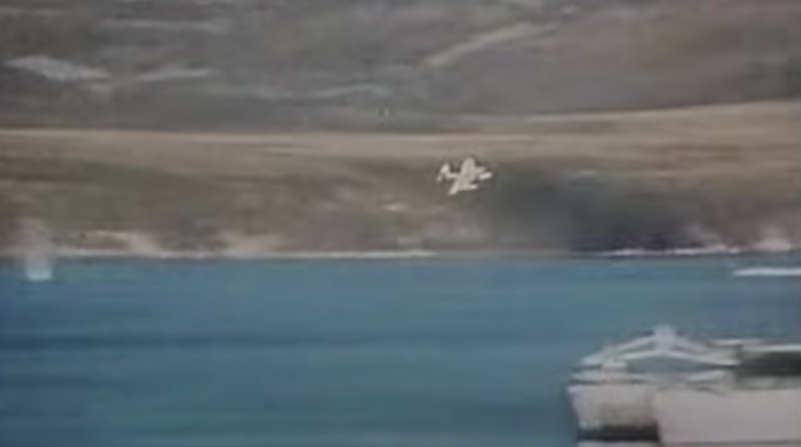This footage has been around for quite some time, but it is still worth watching.
In May 1982, the Battle of San Carlos, between Argentine jets and British aircraft and warships during the British landings on the shores of San Carlo Water, was one of the most interesting chapters of the Falklands War (Malvinas for the Argentine people), a conflict that has provided us several case studies: long range strikes, sabotage attempts, aerial support to an amphibious force and insane low altitude attack runs.
Between May 21 and 25, 1982, ultra low-flying land-based Argentine A-4 (operated by both the Argentine Air Force and the Argentine Naval Aviation) and IAI Dagger aircraft carried out repeated attacks on ships of the British Task Force supporting the British amphibious landings in the inlet located off Falkland Sound. San Carlo Water is the name of a strait between East and West Falkland, chosen by the British landing force because it was quite far from Stanley (where the Argentine troops were based) and also because the terrain would protect them by the eventual attacks with Exocet missiles or submarines.
Although the landing took the Argentines by surprise, the Argentine Air Force jets bravely fought against the Royal Navy in the San Carlos Water fjord, flying low and fast at the limit of their operational range to avoid the interception by the British Sea Harriers in Combat Air Patrol and get close to their targets then evading the surface-to-air missiles fired by the warships under attack.
In this video, you can see some of the repeated air attacks by low-flying Argentine jets during the amphibious landing. While some of the footage has been around for quite some time, it’s still quite interesting to see the light attack jets maneuvering at low altitude over the sea in their attempt to attack the British ships.
In 2012, we posted a series of articles about the Falklands war. Among them, one was the story of an A-4 pilot, Captain Alberto Jorge Philippi, who took off from the Rio Grande naval base as part of a three-ship A-4 Skyhawk formation and headed towards the Malvinas at 27,000 feet to take part in the air strikes. Here’s an excerpt (for the full story click here):
Once Philippi and his colleagues were 100 miles from the islands they dropped to an altitude of 100 feet. Philippi describes how the weather was poor with low clouds and rain as they followed the coast to the southern entrance to the San Carlos sound where they dropped to an altitude of 50 feet.
Even though the radar altimeter was set to sound at 30 feet, Philippi mentions how it went off numerous occasions as they sped up the sound towards the British fleet which was in the process of landing thousands of troops from amphibious landing craft.
Philippi then spotted the masts of a ship amongst the rocks at his 11 O’clock and signalled to his colleagues this was to be their target. After closing to the rocks to hide his aircraft and confuse the frigates fire control radar, Philippi turned hard wing tip skimming the wave tops to bring the target onto his nose.
Once Philippi was 1,000 – 1,500 meters from the Frigate (HMS Ardent) he performed a pop-up delivery from around 300 feet, waited for the cross hairs to meet over the bow of the ship and released his weapons.
Once the bombs were away, Philippi turned hard to the right whilst loosing the altitude he had gained to deliver his weapons back down to the 50 feet he was at prior to release.
Seconds later, Philippi’s colleague Jose Cesar Arca’s voice came over the radio and said “Very Good Sir” as the bombs impacted the back of the ship. Arca’s bombs also found their target even though Arca had flown through the debris and smoke kicked up by Philippi.
The pilots had decided to escape using the route they had used to get to the target area but, within minutes, Marcelo Gustavo Marquez, the third pilot of the same formation, shouted “Harrier! Harrier!” down his radio.
[…]
The British sustained significant losses and damage (1 destroyer and 2 frigates sunk, 8 ships damaged and 4 helicopters lost, along with 49 killed) but were able to establish a beachhead and land troops.
As already commented when talking the lessons learned of the Falklands War, 40 years later, the type of stand off weaponry available today make the attack profile shown in the video a bit anachronistic. However, as discussed with several pilots lately, not even in the age of stealth aircraft and PGMs (Precision Guided Munitions) you can rule out the possibility to have to descend to ultra low altitude to evade a threat or to engage an enemy target. This is the reason why modern combat pilots, flying all kinds of aircraft, including strategic airlifters, still spend some of their flying time at low level.









